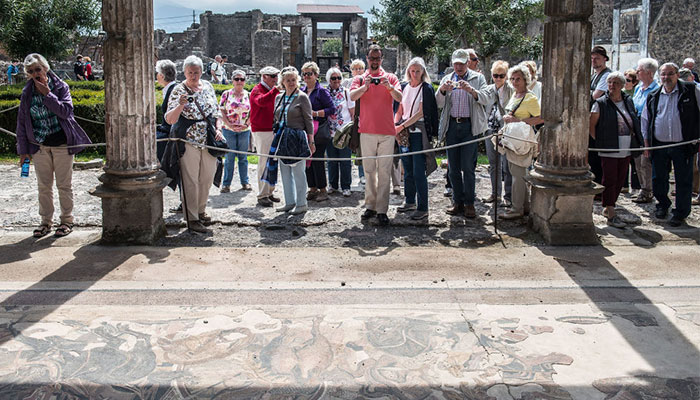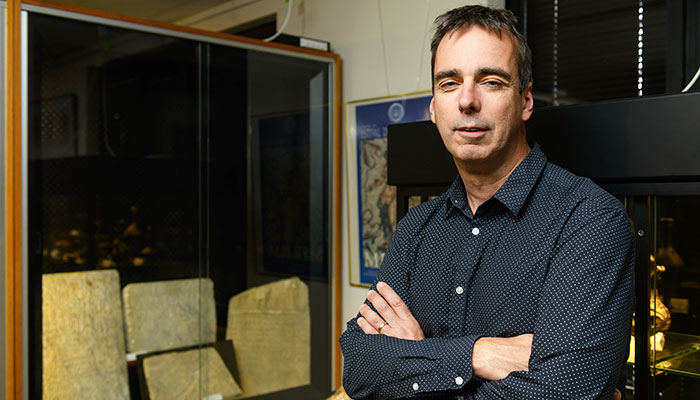Pompeii has been captivating visitors for more than 200 years because it invites us to try and imagine ourselves caught in the catastrophic events of AD79, even if it is beyond our grasp.
The lethal eruption of volcano Mount Vesuvius happened in the midst of daily life in a middle-sized Roman town, and the archaeology reveals a sense of urgency.
We can see loaves of bread that were still baking in the oven, and skeletons of people who tragically died attempting to flee.
Other people sheltered in groups in what they hoped were safe places in houses, but died by asphyxiation from toxic gases or heat from the pyroclastic flow.
The scene would have been chaotic and terrifying. Day turned to night as the eruption sent ash, pumice and volcanic debris up into space with violent force and blocked out the sun.
The story of Pompeii is embedded in our culture now, and it will stay as a major tourist destination, short of Vesuvius erupting again – which is always a possibility.
That material then rained down and then moved very rapidly in pyroclastic surges at roughly 20 metres per second. Everything above the ground floor was sheared off, roofs collapsed and huge objects were displaced .
A lot of people did leave after the initial explosion, but at least 1000 people died, many of whom may have found it difficult to travel. The skeletons which have been studied show a high number of pregnant women among them.
Mt Vesuvius, an active volcano, is very present at Pompeii; it’s constantly in the background as you walk its streets. So there’s a combination of volcanology and archaeology, two interests running in paralleI, which makes the site unique.
Bars, shops and restaurants
Pompeii also gives us a detailed picture of everyday life in a Roman town, which helps bring the past to life. It was a bustling, densely populated place with shops, bars, religious sites and public buildings with graffiti scrawled on the walls and typical urban problems like roads that needed fixing.

Pompeii was already recovering from a previous earthquake in AD62 and was in the process of rebuilding.
Residents walked on pavements past streets lined with shops, a Roman invention. There were bakeries, furniture shops and ‘fulleries’ – vats for washing textiles and clothing. A shop was even found with bird cages.
There were numerous bars – 164 of them have been uncovered – selling everything from cheap local wine to high quality imports from the Greek islands, as well as food such as olives, figs and bread.
Walking down the street you’d also come across water fountains and shrines to the gods at crossroads, with bars and bakeries nearby because people tended to congregate there.
It would take only 15 minutes to walk across Pompeii, but it was densely packed compared with a classic Sydney suburb, with a population of somewhere between 12,000 and 20,000 people within 66 hectares.
The streets of Pompeii were paved in the first century BCE so at the time of the eruption the stone had already worn and ruts had formed. There is evidence the Pompeiians poured molten iron in the ruts to restore them.
They didn’t have stormwater drains so put crossing stones in place to ensure you didn’t get your feet wet, but that also made it difficult for carts to pass so navigating the streets could be challenging.
Many more discoveries to come
Most of the graffiti found at Pompeii is people writing their names, and there are also more than a hundred examples of alphabet graffiti, as both adults and children practiced letter writing.

There were also painted notices for elections or shows in the amphitheatre done by professional signwriters, in red paint. And lots of drawings of gladiators and ships, as well as classic stick figures by young children which are exactly the same shapes as those drawn by primary school children today.
One third of Pompeii remains to be excavated, but the focus is now on conservation of the existing site. Recent archaeological digs have aimed at reinforcing the edges of the excavation to prevent pressure of the soil on the ancient walls and rainwater run-off. Still, they have brought to light exciting new findings, such as the 2018-2020 Regio V dig which revealed a Thermopolium, or ancient snack bar with a painted counter and jars of food such as duck and rooster.
All these glimpses of daily life give us the possibility of understanding, and empathy with ordinary people, at a moment just before they suffered a catastrophe. Pompeii has an enduring popularity, with about 2.5 million visitors each year and history students are fascinated by it.

Professor Ray Laurence (pictured above) is Discipline Chair, Ancient History, in the Department of History and Archaeology, Macquarie University.
And it still yields surprises. There is now discussion that the eruption may have occurred in the northern autumn, rather than the traditionally held date of August 24, partly because of the discovery of seasonal fruit such as pomegranates. Walking through the streets of Pompeii, there is the possibility of seeing something new every time, and it is our job as academic archaeologists to interpret data in new ways.
The story of Pompeii is embedded in our culture now, and it will stay as a major tourist destination, short of Vesuvius erupting again – which is always a possibility.
Watch more video animations on Ancient Rome
Pompeian Streets, above, is a a new short cartoon created by Professor Ray Laurence aimed at HSC students and teachers. This film is part of a new series of Pompeii films to be released each month from October 2023 on the Ancient Rome in Motion YouTube channel. Professor Laurence’s earlier films Teenage Life in Ancient Rome and Four Sisters in Ancient Rome have more than 20 million views on YouTube.








